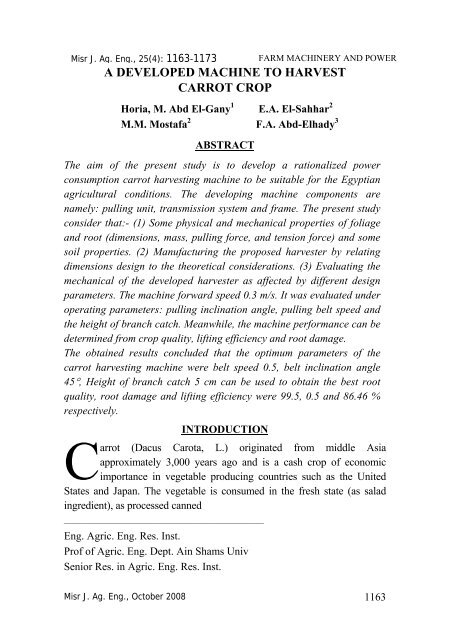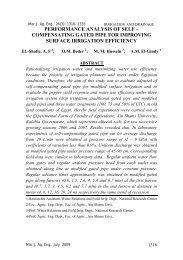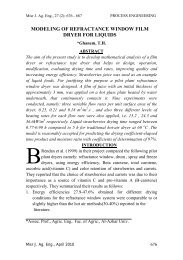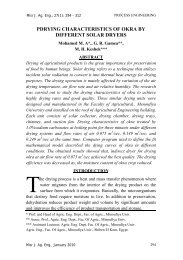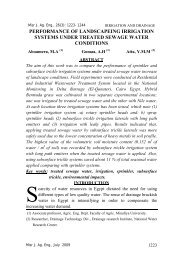a developed machine to harvest carrot crop - Misr Journal Of ...
a developed machine to harvest carrot crop - Misr Journal Of ...
a developed machine to harvest carrot crop - Misr Journal Of ...
You also want an ePaper? Increase the reach of your titles
YUMPU automatically turns print PDFs into web optimized ePapers that Google loves.
<strong>Misr</strong> J. Ag. Eng., 25(4): 1163-1173A DEVELOPED MACHINE TO HARVESTCARROT CROPHoria, M. Abd El-Gany 1 E.A. El-Sahhar 2M.M. Mostafa 2 F.A. Abd-Elhady 3ABSTRACTFARM MACHINERY AND POWERThe aim of the present study is <strong>to</strong> develop a rationalized powerconsumption <strong>carrot</strong> <strong>harvest</strong>ing <strong>machine</strong> <strong>to</strong> be suitable for the Egyptianagricultural conditions. The developing <strong>machine</strong> components arenamely: pulling unit, transmission system and frame. The present studyconsider that:- (1) Some physical and mechanical properties of foliageand root (dimensions, mass, pulling force, and tension force) and somesoil properties. (2) Manufacturing the proposed <strong>harvest</strong>er by relatingdimensions design <strong>to</strong> the theoretical considerations. (3) Evaluating themechanical of the <strong>developed</strong> <strong>harvest</strong>er as affected by different designparameters. The <strong>machine</strong> forward speed 0.3 m/s. It was evaluated underoperating parameters: pulling inclination angle, pulling belt speed andthe height of branch catch. Meanwhile, the <strong>machine</strong> performance can bedetermined from <strong>crop</strong> quality, lifting efficiency and root damage.The obtained results concluded that the optimum parameters of the<strong>carrot</strong> <strong>harvest</strong>ing <strong>machine</strong> were belt speed 0.5, belt inclination angle45, Height of branch catch 5 cm can be used <strong>to</strong> obtain the best rootquality, root damage and lifting efficiency were 99.5, 0.5 and 86.46 %respectively.INTRODUCTIONCarrot (Dacus Carota, L.) originated from middle Asiaapproximately 3,000 years ago and is a cash <strong>crop</strong> of economicimportance in vegetable producing countries such as the UnitedStates and Japan. The vegetable is consumed in the fresh state (as saladingredient), as processed canned Eng. Agric. Eng. Res. Inst.Prof of Agric. Eng. Dept. Ain Shams UnivSenior Res. in Agric. Eng. Res. Inst.<strong>Misr</strong> J. Ag. Eng., Oc<strong>to</strong>ber 2008 1163
peeled <strong>carrot</strong> or as a dehydrated product usually as a constituent of souppowder and flavoring for convenience foods. Carrots are rich sources ofdietary fiber as well as beta-carotene, which the body converts <strong>to</strong> VitaminA. Therefore, in Egypt the cultivated area of <strong>carrot</strong> was 10218 feddan, andits production was about 121333 <strong>to</strong>n (Ministry of agricultural 2005).Honma et al. (1974) stated that progress made in vegetable breedingduring the last three decades, is surveyed social change affected breeding.Objectives of depending on mechanization development of varietieswhich are suitable for mechanical <strong>harvest</strong>ing and are uniform in maturity<strong>carrot</strong>, <strong>to</strong>ma<strong>to</strong> and phaseolus. Which have been <strong>developed</strong> for mechanized<strong>harvest</strong>ing.Bajkin (1984) stated that the mechanized picking of <strong>carrot</strong>, parsley,parsnip and celery. Root losses quality of performed work, explosionindica<strong>to</strong>rs (consumption of man labor and <strong>machine</strong> work) depending onusing <strong>machine</strong>s (combines root diggers) were determined for eachvegetable <strong>crop</strong>.Guarnieri (1989) studied that, <strong>to</strong> be economically the new generationof vegetable <strong>crop</strong> <strong>harvest</strong>ers require <strong>to</strong> be used on mechanical<strong>harvest</strong>ing will become more important <strong>to</strong> reduce the problems of<strong>crop</strong> spoilage between <strong>harvest</strong>ing and point of sale electronic controlsystems choice of cultivar suitable for mechanical <strong>harvest</strong>ing, transportingand grading are some of the developments <strong>to</strong> expected in the fairly nearfuture <strong>crop</strong>s discussed include <strong>to</strong>ma<strong>to</strong>es, artichokes, peppers, cauliflowers,<strong>carrot</strong> and spinach.Leunov (1989) found that vegetable growing as part of the agriculturalsystem discussed with special reference <strong>to</strong> mechanization. The his<strong>to</strong>ry offield equipment in the USSR is briefly reviewed and development of newgenerations of <strong>machine</strong>s <strong>to</strong> modernize cultural system is mentioned on theeconomic effectiveness of cabbage, <strong>carrot</strong>, beet root and onion productionby system based on <strong>harvest</strong>ing <strong>machine</strong>s of different working widths (4.2and 5.4 m).Milling<strong>to</strong>n (1984) found that mechanical damage during lifting andprocessing in the packhouse leads <strong>to</strong> the loss ranges from 20 – 50 % ofthe roots <strong>harvest</strong>ed and packhouse the lines were examined <strong>to</strong> asses thetype and degree of damage caused.<strong>Misr</strong> J. Ag. Eng., Oc<strong>to</strong>ber 2008 1164
Bar et al.(1988) stated that <strong>carrot</strong> production on very wide ridge using thefield power unit (FPU) and on conventional ridge using conventionaltrac<strong>to</strong>rs was compared. The yield of <strong>carrot</strong> ranged from 4.2 <strong>to</strong>n/fed <strong>to</strong> 7.14<strong>to</strong>n/fed. Depending on the wide ridge. The loss was mainly attributable <strong>to</strong>problems on steering the mechanical <strong>harvest</strong>er.Zufanak and goda (1990) stated that five cultivars of <strong>carrot</strong> were used inexperiment and assessing the efficiency of an Em -11 one- row <strong>carrot</strong><strong>harvest</strong>er pulled by trac<strong>to</strong>r. They found that the <strong>harvest</strong>er performs betterin plots with higher <strong>crop</strong> density decreasing the root damage at the sametime.Ozarsan et al. (1990) stated that the possibilities of <strong>harvest</strong>ing <strong>carrot</strong>smechanically in Turkey were investigated <strong>to</strong> reduce labor requirementsand reduce <strong>harvest</strong>ing losses which are incurred when <strong>carrot</strong>s areploughed up for manual <strong>harvest</strong>ing.El-Sherief (1996) and Khodeir (2002) concluded that the increasingforward speed increase cut and bruise roots while it decreased the liftingefficiency.Mady (2001) found that the mechanical <strong>harvest</strong>ing lead <strong>to</strong> decrease thepercentage of scarified roots and cut roots by 39.55 and 51.39 %,respectively under mechanical planting. But it equal <strong>to</strong> 12.9 and 9.39 %lower than traditional planting system .The mechanical <strong>harvest</strong>ingincreased the percentage of undamaged roots by 14.11 and 7.88 % higherthan traditional <strong>harvest</strong>ing under mechanical and traditional plantingsystems.Abd – Rabou (2004) concluded that by decreasing forward speed tended<strong>to</strong> decrease <strong>to</strong>tal damaged roots. It is clear that, increasing forward speedfrom 0.55 <strong>to</strong> 1.06 m/s tends <strong>to</strong> increase the <strong>to</strong>tal damaged roots from 4.51<strong>to</strong> 5.4% . The highest value of the <strong>to</strong>tal damaged roots of 6.2% wasobtained at forward of 1.06 m/s therefore, the lowest value of the <strong>to</strong>taldamaged 3.4%was obtained at forward speed of 0.55 m/s.The aim of the present study is develop and evaluate the <strong>carrot</strong> <strong>harvest</strong>ing<strong>machine</strong> <strong>to</strong> reduce the power requirement<strong>Misr</strong> J. Ag. Eng., Oc<strong>to</strong>ber 2008 1165
MATERIALS AND METHODSThe <strong>developed</strong> <strong>harvest</strong>er was constructed according <strong>to</strong> the theoreticalrelation ship and its implement includes three main units namely: pullingunit, transmission systems and main frame. The <strong>harvest</strong>ing <strong>machine</strong>pho<strong>to</strong>graphy view, elevation and plane view shown in Figs. (1 and 2).The construction details of the pulling unit was built and constructedlocally according <strong>to</strong> the theoretical relation ship and fitted <strong>to</strong> the<strong>developed</strong> <strong>harvest</strong>er. It was made of steel sheet fixed on the <strong>machine</strong>frame. The pulling unit consists of three main parts fixed by especialframe units namely pulling belt, hoops group and belt fixed unit. The<strong>machine</strong> forward speed is constant at 0.3 m/s. Also, the studiedparameters were carried out in Kalabsho village Dakahlia governorate at2006-2007. The experimental study were done at split plot design in threereplicates. These parameters were five levels of pulling inclination angle() of 25, 30, 35, 40 and 45, three levels of pulling belt speed (S) of 0.5,1.0 and 1.5 m/s and three levels of the height of foliage catch (H) of 5, 10and 15 cm.The measurement were carried out <strong>to</strong> determine some physical andmechanical properties of <strong>carrot</strong> (root length (L), root maximum diameter(d max ), height of foliage (H), root mass (M), tension force () and pullingforce that were determined from random samples of <strong>carrot</strong> plant directlybefore <strong>harvest</strong>ing <strong>to</strong> focus on the properties of design and operating basic.Then the properties of the soil such as ridge profile, penetrationresistance, bulk density and moisture content are measured.To evaluate the performance of the <strong>developed</strong> <strong>machine</strong> the followingequation were used:Number of un - damaged rootsCrop quality Number of <strong>to</strong>tal root <strong>harvest</strong>ingNumber of lifting rootsLiftinf efficiency 100Total root numberNumber of root damageRoot damage 100Total root number 100<strong>Misr</strong> J. Ag. Eng., Oc<strong>to</strong>ber 2008 1166
Fig. 1: A simple <strong>carrot</strong> <strong>harvest</strong>er.Fig. 2: An elevation and plan views of the <strong>carrot</strong> <strong>harvest</strong>er.<strong>Misr</strong> J. Ag. Eng., Oc<strong>to</strong>ber 2008 1167
RESULTS AND DISCUSSIONThis study was conducted mainly <strong>to</strong>:1- Some important properties of <strong>carrot</strong> plantsThe important properties of <strong>carrot</strong> root were; length (L), diameter (d),mass (M), length of foliage (L f ), volume (V), foliage tensile force (T f ) andfoliage tensile failure failer (T ff ). Table (1) summarized the average andcalculated some properties measurements of <strong>carrot</strong> plants.Table 1: Some properties of <strong>carrot</strong> plant.Properties Average valueLength, mm 137.14 ± 29.23Diameter, mm 31.30 ± 3.56Mass, g 84.44 ± 15.13Volume, cm 3 36.90 ± 16.25Foliage length, mm 50.56 ± 4.87Tensile force, N 84.20 ± 13.64Tensile failure , N 127.10 ± 21.81The data from table (1) cleared that the average of the main dimensions ofthe <strong>carrot</strong> are 137.14 ± 29.23 mm, 50.56 ± 4.87 mm, 31.30 ± 3.56 mm,84.44 ± 15.13 N and 36.90 ± 16.25 cm 3 for <strong>carrot</strong> root and foliagelengths, diameter, mass and volume. Therefore, the foliage tensile failureincreased about 42.9 N more than the foliage tensile forces.2- Carrot ridge propertiesThe <strong>carrot</strong> ridge properties such as profile, penetration resistance, bulkdensity and moisture content, were measured directly before <strong>harvest</strong>ing.The ridge profile is illustrated in Fig. (3). It cleared that the upper widthof ridge was about 700 mm and its height of 130 mm. Therefore, the datain table (2) show that the average values of ridge properties, soilpenetration resistance, bulk density and moisture content of 130 N, 1.34g/cm 3 and 25 % respectively.3. Evaluation the <strong>developed</strong> <strong>harvest</strong>er under some operating parametersa- Root qualityFig. (4) clear that the effect of belt inclination angle on root quality at<strong>Misr</strong> J. Ag. Eng., Oc<strong>to</strong>ber 2008 1168
Mastaba height, mm1401201008060402000 100 200 300 400 500 600 700Ridge width, mmFig. (3) Ridge profile of <strong>carrot</strong> plant.Table 2: The soil physical and mechanical properties at different depthDepthProperties Penetration Bulk density, Moistureresistance, N g/cm 3 content, %5 145 1.31 2110 135 1.31 2315 130 1.33 2420 120 1.35 2525 120 1.36 25Root quality, %10099.59998.59897.5Belt speed, m/s0.5 11.59720 25 30 35 40 45 50Belt inclination angle, degreeFig. 4: The effect of belt inclination angle on root quality.different belt speeds. From the figure the increasing in belt inclinationangle from 25 <strong>to</strong> 45 the root quality increase from 98.90 <strong>to</strong> 99.5, 98.48<strong>to</strong> 99.28 and 97.99 <strong>to</strong> 99.08 respectively at belt speeds of 0.5, 1.0 and 1.5m/s. Therefore the data cleared that the root quality increased bydecreasing the belt speed. However, the root quality increase as averagefrom 98.49 <strong>to</strong> 98.22 % by the belt speed decrease from 1.5 <strong>to</strong> 0.5 m/s.<strong>Misr</strong> J. Ag. Eng., Oc<strong>to</strong>ber 2008 1169
- Root damageFig. (5) show that the relationship between belt inclination angle and rootdamage at different belt speeds. The figure illustrated that increasing beltinclination angle from 25 <strong>to</strong> 45 the root damage decrease from 1.0 <strong>to</strong>0.5 at belt speed 0.5 m/s, 1.5 <strong>to</strong> 0.8 at belt speed 1.0 m/s and 2.0 <strong>to</strong> 1.0 atbelt speed 1.5 m/s. Therefore the data cleared that the root damageincrease as average from 0.77 <strong>to</strong> 1.51 % by increasing belt speed from0.5 <strong>to</strong> 1.5 m/s.2.52Belt speed, m/s0.5 11.5Root damage, %1.510.5020 25 30 35 40 45 50Belt inclination angle, degreeFig. 5: The relationship between belt inclination angle and root damage.c- Lifting efficiencyFig. (6) clear that the effect of inclination angle on lifting efficiency atdifferent belt speed and height of foliage catch. From the figure theincreasing in belt inclination angle from 25 <strong>to</strong> 45 the lifting efficiencyincrease from 78 <strong>to</strong> 82, 76 <strong>to</strong> 80 and 73 <strong>to</strong> 76 % respectively at the beltspeed 0.5, 1.0 and 1.5 m/s and height of foliage catch of 5 cm. On theother side, at the foliage catch 10 cm the figure (6) illustrate that theincreasing in belt inclination angle from 25 <strong>to</strong> 45 the lifting efficiencyincrease from 69 <strong>to</strong> 73, 68 <strong>to</strong> 71 and 64 <strong>to</strong> 68 % respectively at belt speed0.5, 1.0 and 1.5 m/s and at height of foliage catch of 10 cm. Therefore, theabove figure show that the increasing in belt inclination angle from 25 <strong>to</strong>45 the lifting efficiency increase from 68 <strong>to</strong> 73, 64 <strong>to</strong> 68 and 61 <strong>to</strong> 65 %respectively at speeds of 0.5, 1.0 and 1.5 m/s and at height of foliagecatch of 15cm. Subsequently, the data cleared that the lifting efficiencyincreased by decrease the belt speed.<strong>Misr</strong> J. Ag. Eng., Oc<strong>to</strong>ber 2008 1170
8884Height of branch catch5 cmLiffting efficincy, %Liffting efficincy, %80767268Belt speed, m/s640.51.516020 25 30 35 40 45 50Belt inclination angle, degree88848076726864Belt speed, m/s0.5 11.510 cm6020 25 30 35 40 45 50Belt inclination angle, degreeLiffting efficincy, %88848076726864Belt speed, m/s0.5 11.515 cm6020 25 30 35 40 45 50Belt inclination angle, degreeFig. 6: The effect of inclination angle on lifting efficiency at different beltspeed and different height of foliage catch.<strong>Misr</strong> J. Ag. Eng., Oc<strong>to</strong>ber 2008 1171
On the other side the belt speed decreased from 1.5 <strong>to</strong> 0.5 the liftingefficiency increasing as average from 78.86 <strong>to</strong> 83.21, 68.30 <strong>to</strong> 73.13 and66.42 <strong>to</strong> 72.56 % respectively at height of foliage catch 5, 10 and 15 cm.Meanwhile the lifting efficiency were 81.09, 70.66 and 69.38 % at heigh<strong>to</strong>f foliage catch 5, 10 and 15 cm respectively.CONCLUSIONFrom the obtained results the study can be concluded that the optimumparameters of the <strong>carrot</strong> <strong>harvest</strong>ing <strong>machine</strong> were belt speed 0.5, beltinclination angle 45, Height of branch catch 5 cm can be used <strong>to</strong> obtainthe best root quality, root damage and lifting efficiency were 99.5, 0.5 and86.46 % respectively.REFERENCESAbd-Rabou, A.F. (2004). Manufacturing a small <strong>machine</strong> <strong>to</strong> suit<strong>harvest</strong>ing sugar beet under Egyptian conditions. PhD Thesis Agric.Mech. Dept. Fac. of Agric. Kafr El–Sheikh. Tanta Univ.Bajkin, A. (1984). Evaluation of work quality and effect of <strong>machine</strong>ryaggregates for digging root like vegetables, savremena- poljorivednatehnika. (yugoslavia). 1984, vol. 10(12): 29-34El–Sherief, R.R.A. (1996). A study on <strong>harvest</strong>ing mechanization of sugarbeet. PhD Thesis Agric. Mech . Dept. Fac. of Agric. Kafr El–Sheikh. Tanta Univ.Guarnieri, A. (1989). The development of <strong>harvest</strong>ers for vegetable <strong>crop</strong>s.Machine -e-motroi Agricolill trat<strong>to</strong>rista 1989, 47(2): 31-33.Honma, S.; R. An<strong>to</strong>szewski and L. Harrison (1979). Implication ofrelevant genetic changes in vegetables. Proc. of the xix I.: Hort.Cong., III. Section VIII vegetables: 465-473.Leunov, L. L. (1989). Technology of vegetable production, theory andpractice vestnik sel'skokozyzistvennionauki. Maskva, 5: 107-112.Mady, M. A. (2001). Mechanization of some operations for sugar beetproduction. <strong>Misr</strong>. J. Agric. Eng., 18 (2) : 339 – 355.Milling<strong>to</strong>n, S. (1984). Quality of <strong>carrot</strong>s in the united kingobom with respect<strong>to</strong> <strong>harvest</strong>er and packhouse damage. Acta. Hort. 163: 127-136.<strong>Misr</strong> J. Ag. Eng., Oc<strong>to</strong>ber 2008 1172
Ministry of Agriculture and Land Reclamation Economic Affairs Sec<strong>to</strong>r(EAS) (2005). Study of the indica<strong>to</strong>rs agricultural statistics. 85.Ozarslan, C; D. Erdogan and Y. Zeren (1990). Mechanizationpossibilities on <strong>carrot</strong> <strong>harvest</strong>ing, I. Cong. Mee. and Energy inEgr.Proc. of cont. held in Adana, Turky, 374-282.Zufanek, J. B. Groda (1990). The influence of the <strong>carrot</strong> <strong>crop</strong> organizationon the <strong>harvest</strong>ing equipment performance and quality of work.Zemedelska Technika. 36(1): 37-45.م. حورية محمد عبد الغنىأ.د. مبارك محمد مصطفى٢الملخص العربىتطوير آلة لحصاد محصول الجزر١أحمد فضل٢أ.د. عصام أحمد السحارد. فتحى عبد الحليم عبد الھادى٣يھدف ھذا البحث إلى تطوير آلة لحصاد الجزر تقلل من إستھالك القدرة تناسب الظروفالمصرية. ھذه اآللة تصنع من خامات محلية وتعتمد من حيث التصميم على تقنية جذب وشدجذور الجزر (تقليع). وتتكون اآللة من وحدة تقليع الجذور، نظام نقل القدرة، واإلطار. ومنخالل ھذا البحث تم دراسة بعض الخواص الطبيعية والميكانيكية للجزر (األبعاد الرئيسية للجذر،الكتلة، قوة الرفع، قوة الشد) وللتربة المحيطة (شكل الخط، مقاومة اإلختراق، الكثافة الظاھرية،نسبة الرطوبة)، وذلك بھدف إستخدامھا كقاعدة بيانات لتصميم وتشغيل أجزاء اآللة المختلفة. وقدتم إستخدام اآللة عند سرعة تقدم ٠.٣ م/ث، كما تم اختبار وتقييم أداء اآللة المطورة عند عواملالدراسة (زاوية الرفع، سرعة السير، إرتفاع مسك العرش). وقد تم الحصول على أفضل نتائجلجودة الجذورزاوية رفع º٤٥، سرعة سير ٠.٥ متر/ساعة، إرتفاع مسك العرش ٥ سم.(٩٩.٥ %)، الجذور التالفة (٠.٥ %)، كفاءة الحصاد (الرفع) (٨٦.٤٦ %) عندمھندسة بمعھد بحوث الھندسة الزراعية، مركز البحوث الزراعية.أستاذ دكتور بكلية الزراعة – جامعة عين شمس.باحث أول بمعھد بحوث الھندسة الزراعية، مركز البحوث الزراعية.<strong>Misr</strong> J. Ag. Eng., Oc<strong>to</strong>ber 2008 1173


